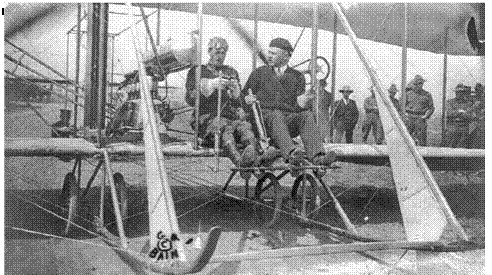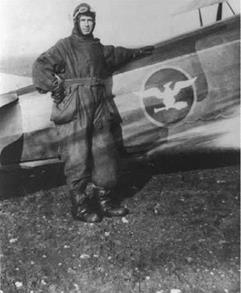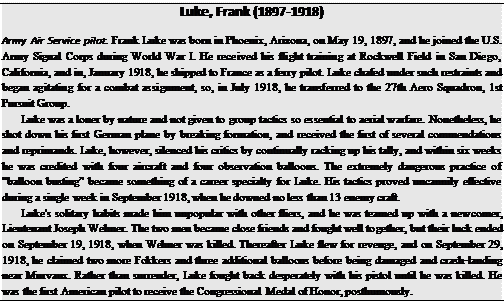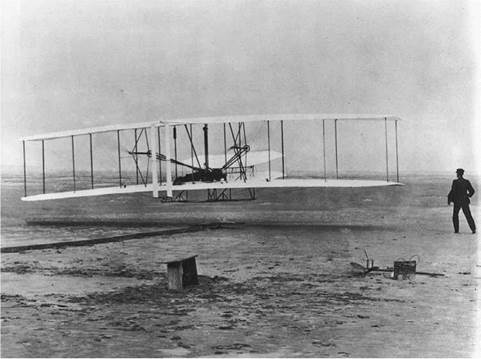Introduction
|
T |
he popular expression “Wild Blue Yonder” conjures up imagery of fleets of American warplanes, invincible in combat and in seemingly endless abundance. However, such popular notions belie the relatively humble origins of the U. S. Air Force, and its forebears. American military aviation is rooted in the U. S. Army Signal Corps, which operated reconnaissance balloons during the Civil War. It was not until airplanes became technologically feasible that the Signal Corps Aeronautical Division manifested in 1907, which, in turn, gave way to the Signal Corps Aviation Section in 1917. However, the United States had fallen far behind Europe in terms of military aviation by the advent of World War I, and it was not until May 1918 that the U. S. Army Air Service arose to manage the 10-fold increase in machines and personnel. Despite this shaky start, the Air Service acquitted itself well in combat, downing 756 enemy aircraft and 76 balloons at a cost of 289 aircraft, 48 balloons, and 237 crewmen. Success here stimulated cries for an independent air force, free of army control, and of which General William G. “Billy” Mitchell was the most vocal proponent.
Over the next decade a series of aviation boards and studies concluded that American air power merited greater recognition as a quasi-independent arm, so in 1926 the Army Air Corps was born. Despite a lack of funding brought on by the Depression era, America airmen managed to make significant technological and doctrinal strides with a number of historic flights, and new institutions such as the Air Corps Tactical School. Among the most significant creations was the General Headquarters Air Force (GHQ), which enjoyed a measure of autonomy from the Army and formed the kernel of American strategic bombing. By 1941, the inadequacies of the Army Air Corps forced it to give way to the new Army Air Forces (AAF), whereby commander General Henry “Hap” Arnold enjoyed coequal status and recognition with leaders of traditional ground forces. The war was also a turning point in American aviation history, for the AAF emerged as a conquering force of 1.2 million men and 160,000 airplanes, unprecedented in the annals of warfare. Significantly, AAF B-29s named Enola Gay and Bock’s Car ushered in a defining moment in human history by dropping atomic bombs on Hiroshima and Nagasaki, respectively, and heralding the dawn of nuclear warfare.
The dream of an independent air arm was finally realized in 1947 when the U. S. Air Force emerged through the National Security Act of that year. The new organization performed splendidly during the Korean War, 1950-1953, the West’s first challenge of the Cold War, and by decade’s end had pioneered the development and deployment of new Atlas, Titan, and Minuteman intercontinental ballistic missiles. However, despite more capable aircraft and heroic sacrifices, the Air Force proved unable to materially change the course of events in the Vietnam War, or its collateral theaters in Laos and Cambodia. Thereafter, the Air Force concentrated on the acquisition of even more modern weapons systems, lavish in price and capabilities in combat, and proved itself capable of neutralizing the threat posed by the mighty Red Air Force. Ironically, its greatest challenge was mounted not by the Soviet Union but rather Iraq, during its invasion of neighboring Kuwait. The Air Force proved itself up to the challenge of defeating this modern, up-to-date adversary in an aerial campaign lasting 39 days, which enabled Operation desert storm to triumph in only 100 hours on the ground. Since the end of the Cold War in 1991, the Air Force has continued displaying its global flexibility and capacities in Bosnia, Kosovo, Afghanistan, and Iraq, all of which reinforce its reputation as a high-tech, unbeatable adversary, and
America’s first line of defense in the war against terrorism.
This chronology is an attempt to capture the impressive historical sweep of the U. S. Air Force, and its antecedents, in a single volume. To that end, all important conflicts and personages are covered to properly contextualize military events at the time they occurred. Great care is also taken to mention important laws, military texts, schools, weapons systems, and occasional political developments affecting military affairs. Overall, this book should sketch out for lay readers the growth and maturation of American military aviation, while the detailed bibliography ofthe latest scholarship points the way to subsequent inquiries. It will also afford prospective researchers a workable time frame, or stepping-off point, from which they can investigate events and personalities of interest. The author would like to thank editors Padraic Carlin and Andy McCormick for their support and advice in compiling what the author hopes is a useful and relevant addition to any library shelf, public or private.
—-John C. Fredriksen, Ph. D.
June 18 In Virginia, Professor Thaddeus S. C. Lowe sends the first aerial telegraph message from a balloon tethered to the vessel Enterprise.
September 24 Over Washington, D. C., Professor Thaddeus S. C. Lowe flies a balloon 1,000 feet across the Potomac
River; his messages assist Union gunners bombarding Confederate positions in Virginia.
OCTOBER 1 The U. S. Army establishes a Balloon Corps, which musters fifty men and five balloons. This is the first formation of its kind in military history.
1916JANUARY 5 In the Philippine Islands, the 1st Company, 2nd Aero Squadron deploys as the first complete aviation unit assigned outside the United States. January 17 The United States verges on the cusp of war with Germany, yet the Army Air Service only boasts 49 personnel and 25 aircraft. By the end of 1918 they will possess 19,068 aircraft, but the bulk of these are obtained from either France or England. MARCH 15 At Columbus, New Mexico, the 1st Aero Squadron under Captain Benjamin D. Foulois begins readying pilots and equipment to support General John J. Pershing in Mexico. This is the first American tactical air unit committed to military operations in the field and it operates a handful ofunderpowered Curtiss JN-2 biplanes. MARCH 16 Over Mexico, a Curtiss JN-2 makes aviation history’s first recorded reconnaissance flight. MARCH 21 In France, the French Air Service authorizes creation of the Esca – drille Americaine, better known as the
Lafayette Escadrille, to recruit volunteer pilots from the United States. MARCH 27 The 1st Aero Squadron under Captain Benjamin D. Foulois begins making routine mail and dispatch flights for General John J. Pershing’s Punitive Expedition. April 2 In San Diego, California, Colonel William Glassford arrives to take charge of the Signal Corps Aviation School at Rockwell Field. April 3 Command of the Aeronautics Division, Signal Corps, passes to Captain William “Billy” Mitchell. April 5 At San Geronimo, Mexico, the 1st Aero Squadron establishes a base camp for closer cooperation with ground units commanded by General John J. Pershing. April 7 Over Chihuahua City, Mexico, Lieutenant Herbert A. Dargue and Captain Benjamin D. Foulois are fired upon as they deliver dispatches to the U. S. Consul; this is the first American airplane to receive hostile fire. April 16 At Luxeuil-les-Bains (Vosages), France, the Escadrille Americaine forms from American volunteer pilots and becomes part of the French Aeronautique Militaire. It sees extensive service in skies over the Western Front and, that December, it is renamed the Lafayette Escadrille after famed Revolutionary War hero Marquis de Lafayette. April 20 In France, Sergeant Major Elliot Cowdin is the first American aviator to receive the Medaille Militaire. May 18 Over Thann, Alsace Region, France, Sergeant Kiffin Yates Rockwell of the Escadrille Americaine downs a German observer craft; this is the first aerial enemy kill by an American pilot. May 20 Lieutenant Colonel George O. Squier assumes command of the Aviation Section, Signal Corps. June 3 In Washington, D. C., Congress passes the National Defense Act, which greatly enlarges the Signal Corps Aviation Section beyond its present 60 officers and 260 enlisted men. June 18 Over Verdun, France, aviator H. Clyde Balsley becomes the first American shot down while flying with the Esca – drille Americaine. The French air commander subsequently flies to his airfield and presents the seriously wounded aviator with a Military Medal and a War Cross. June 23 Near Verdun, France, pilot Victor Emmanuel Chapman, flying with the Escadrille Americaine in France, is the first American pilot killed in World War I. Previously, Chapman had been shot down seven times in six weeks and also claimed four German kills. July 13 At Mineola, New York, the 1st Aero Company, New York National Guard, mobilizes for service along the Mexican border. They are not deployed; however, they are the first National Guard air unit requisitioned into federal service. AUGUST 28 Major Benjamin D. Foulois reports that his 1st Aero Squadron, despite severe operational conditions, managed to complete 540 reconnaissance flights, covering 19,533 miles and staying aloft for 346 hours without serious mishap. August 29 In Washington, D. C., Congress appropriates $14 million for use by the Signal Corps to pursue military aeronautics. NACA also receives $82,500 to construct a large aeronautical laboratory at Langley Field, Virginia. SEPTEMBER 2 Over North Island, California, two Signal Corps aircraft, flown by Lieutenants William A. Robertson and Herbert A. Drague, successfully exchange radiotelegraph messages in flight at a distance of two miles. September 6 Army aircraft test drop the first fragmentation bomb. September 13 In San Diego, California, the first aeronautics course for field officers is founded at the Signal Corps Aviation School. OCTOBER 11 In Washington, D. C., the secretaries of War and the Navy agree to create a joint Aeronautics Board to evaluate the requirements for lighter-than-air machines. November 18-20 At Mineola, New York, seven Curtiss JN-4s ofNew York’s 1st Aero Company fly to Princeton, New Jersey, and back under Captain Raynal C. Bolling. They are there to attend a football game but also manage to showcase their cross-country flying ability to the public. December 20 The Army’s new Balloon School is instituted at Fort Omaha, Nebraska. DECEMBER 22 Elmer B. Sperry files a patent application for his “aerial torpedo,” an unmanned airplane piloted by one of his gyrostabilizers. December 30 North of Hampton, Virginia, the Army establishes a new aviation school; it is now Langley Air Force Base, the Air Force’s oldest active base. . 1932JANUARY 1—31 Over Winslow, Arizona, bombers of the 11th Bombardment Squadron drop supplies and relief packages to snowbound Navajo and Hopi Indians. The squadron receives the Mackay Trophy for their humanitarian efforts. JANUARY 11 Major Hugh J. Knerr proposes to establish a basic Air Corps transportation service with air depots based at Sacramento, California; San Antonio, Texas; Fairchild, Ohio; and Middletown, Pennsylvania. MARCH 20 Boeing displays its XP-936 fighter plane, the first all-metal monoplane aircraft evaluated by the Army Air Corps. It enters service as the P-26 Peashooter, being the last Army pursuit craft with an open cockpit, fixed landing gear, and external wing-wire bracing. MARCH 24 The Army Air Corps, delighted by the success rate of the Nor – den Mark XV bombsight in tests held the previous fall, requests 25 such devices for further evaluation. MAY 9 Over Patterson, Ohio, Army captain Albert F. Hegenberger completes a 15-minute blind, solo flight in a “hooded” Consolidated NY-2; he wins the Collier Trophy for his effort. AUGUST 31 Over Freyburg, Maine, an aircraft flown by Captain A. W. Stevens and Lieutenant C. D. McAllister reaches an altitude of five miles to help photograph a solar eclipse. September 3 At Cleveland, Ohio, Major James H. Doolittle pilots the dangerous Granville GeeBee Racer to 294 miles per hour, setting a new land aircraft speed record. September 21 At March Field, California, a Curtiss Condor bomber carries scientists from the California Institute of Technology skyward to measure the intensity of cosmic rays from high altitude. The aircraft are assigned from the 11th Bombardment Squadron of Lieutenant Colonel Henry H. Arnold. 1862 |
|
APRIL 16 Over Virginia, Professor Thaddeus S. C. Lowe uses a hydrogen balloon to assist Union General Fitz-John Porter. However, his tether line breaks and he drifts over Confederate territory, but Lowe waits for a breeze to blow him back across Union lines and he |
descends and relays his findings to Union headquarters. MAY 31—June 1 Over Virginia, the hydrogen balloon Intrepid is flown to convey military intelligence during the Battle of Fair Oaks (Seven Pines). |
|
1892 |
|
|
January In Paris, France, Lieutenant William A. Glassford purchases a balloon for the Signal Corps. It is subsequently named the General Myer and transferred to Fort Riley, Kansas, for the Signal Corps. |
MAY 6 At Quantico, Virginia, Samuel P. Langley launches Aerodrome No. 5, the first pilotless, engine-driven, heavier-than-air craft. The device manages to fly from a catapult mounted on a houseboat for a distance of3,300 feet and 2,300 feet in two flights. |
|
1894 |
|
|
At Fort Logan, Colorado, the Signal Corps balloon detachment arrives from |
Fort Riley, Kansas, in search of better weather conditions. |
1917JANUARY 6 In Washington, D. C., the findings of a joint Army and Navy Board encourages the secretaries of War and the Navy to acquire several lighter-than-air ships based on the proven German Zeppelin design. Funding is also split between the two services, and a new board of three officers from each service arises to ensure close cooperation. JANUARY 9 At San Diego, California, Captain Henry H. Arnold is dispatched to Panama as commander of the 7th Aero Squadron, which, presently, possesses neither bases nor airplanes. At Fort Kamehameha, Hawaii, Captain John F. Curry assumes command of the new 6th Aero Squadron. ■
FEBRUARY 3 In Washington, D. C., the United States formally severs diplomatic relations with Germany in response to the latter’s resumption of unrestricted submarine warfare against neutral shipping. FEBRUARY 10 The National Advisory Committee for Aeronautics (NACA) founds a patent subcommittee to help preclude legal actions threatening the entire industry. FEBRUARY 19 Lieutenant Colonel John B. Bennett assumes command ofthe Aviation Service, Signal Corps, while his predecessor, Lieutenant Colonel George O. Squier, gains appointment as chief signal officer. February 28 At North Island, San Diego, California, the first successful experiments with radiotelephones between aircraft and ground stations transpire. Previous attempts in aerial communication utilized telegraphs. MARCH 13 Brigadier General George O. Squier, chief signal officer, authorizes the Intelligence subdivision of the Signal Corps; this marks the birth of Army Air Intelligence. April 6 When the United States enters World War I, the Aviation Section of the Signal Corps consisted of 35 pilots, 55 training aircraft, and 1,987 enlisted men. Such numbers are woefully inadequate by European standards. April 30 In Europe, Captain William “Billy” Mitchell becomes the first officer of the Army Air Service to fly over enemy territory in a French aircraft; he becomes an outspoken spokesman for American air power. May 5 In Washington, D. C., the secretaries of War and the Navy consent to a “joint technical board” assembled for the standardizing the design and performance specifications of all forthcoming aircraft. May 12 At San Diego, California, Captain W. A. Robertson sets a new altitude record of 17,230 feet over the North Island Flying School. May 16 The Council of National Defense establishes the Aircraft Production Board and entrusts it to Howard Coffin, former CEO of the Hudson Motor Car Company. This body acts in an advisory capacity relative to aircraft development and procurement and signals a massive buildup of American aerial strength for use in World War I. May 23 French premier Alexandre Ribot requests 5,000 American pilots, 4,500 aircraft, and 50,000 aircraft mechanics to assist the Allied war effort, and Major Benjamin D. Foulois is tasked with drawing up a plan for the government to achieve these goals. May 26 Signal Corps Major Townsend F. Dodd gains appointment as AEF aviation officer to General John J. Pershing’s staff. This is a boost to the Aviation Section’s reputation. May 29 In Washington, D. C., Colonel Edwin Deeds collaborates with several designers to conceptualize a standardized engine to American military aircraft. These endeavors culminate in the famous 12-cylinder, 400-horsepower Liberty engine, of which 15,000 are manufactured for the war effort. JUNE 2 The Aviation Section, Army Signal Corps, is redesignated the Airplane Division. June 4 The Aircraft Production Board and the Joint Technical Board on Aircraft authorize five prototypes of 8- and 12- cylinder Liberty motors. These are exceptionally conservative in design, and expressly conceived for mass production. June 17 The Aircraft Production Board dispatches a joint Army-Navy aviation board under Major Raynal C. Bolling to Europe to study and possibly incorporate European production techniques in aircraft production at home. June 30 In France, Lieutenant Colonel William “Billy” Mitchell replaces Major Townsend F. Dodd as Aviation Officer, American Expeditionary Force (AEF). July 4 Rantoul, Illinois, hosts the first military airfield in the United States for training purposes. Presently, the Army Air Service possesses only 55 obsolete aircraft. It ends the war with 16,801 combat aircraft in service, mostly obtained from France. JULY 20 In the Shiloh Valley Township, Illinois, Scott Field is christened by the War Department in honor of Corporal Frank S. Scott, who was killed in a flying accident on September 28, 1912. This is the only base named after an enlisted man. JULY 23 Command of the Airplane Division, Army Signal Corps, passes to Major Benjamin D. Foulois. July 24 In Washington, D. C., Congress makes its first large appropriation for the Army Aviation Section, which receives $640 million. Significantly, the 4,500 new military aircraft manufactured in the United States are either naval patrol craft or army trainers powered by a reliable motor designed by the Packard Motor Car Company, the so-called “Liberty Engine,” of which 15,131 are constructed by war’s end. Manufacturers Aircraft Association is created to implement a cross-licensing agreement, whereby member companies could access all patents at fixed low rates. This obviates the threat of lawsuits. JULY 26 The Army-Navy Airship Board endorses a proposal by the Bureau of Mines to allot a grant of $100,000 and construct a small plant to produce helium in the United States. July 27 A British-built De Havilland DH-4 two-seat bomber arrives in the United States to facilitate production of an American version. Roughly 4,500 are manufactured stateside with the popular 12-cylinder Liberty engine, but only a handful enter combat operations. JULY 28 At Liverpool, England, the 29th Provisional Construction Squadron becomes the first American aero squadron deployed in Europe during the war. AUGUST 5 In Columbus, New Mexico, the 1st Aero Squadron under Major Ralph Royce begins transferring its personnel to training facilities in Avord, France. AUGUST 13 In New York, men and equipment of the 1st Aero Squadron set sail for Europe under Major Ralph Royce. This is the first such unit dispatched to the Western Front. AUGUST 21 The Model F, constructed by the L. W.F. Engineering Company, becomes the first airplane powered by the Liberty engine. AUGUST 22 In the United States, mass production of air-to-ground radiotelephones commences. AUGUST 25 The 12-cylinder, 300-horsepower Liberty engine passes its acceptance test with flying colors and is ordered into production as America’s standard aircraft engine. SEPTEMBER 3 Brigadier General William L. Kenly becomes chief of air service on the AEF staff, an act granting American aerial activities greater recognition and significance. Lieutenant Colonel William “Billy” Mitchell also becomes air commander of the Zone of the Advance. SEPTEMBER 13 In France, the 1st Aero Squadron is the first aviation unit to reach operational status and begin training with the American Expeditionary Force (AEF). They are mostly involved in artillery spotting and tactical reconnaissance. OCTOBER 16 At Langley Field, Virginia, radiotelephone devices installed on two aircraft transmit and receive signals at distances of 25 miles; those sent to ground stations can be heard 45 miles away. OCTOBER 18 At Dayton, Ohio, the Signals Corps assigns McCook Field to serve as its new testing center to facilitate aeronautical research and development in the rapidly changing field of military aviation. In Washington, D. C., the Aviation Medical Research Board is created by the U. S. Army Signal Corps. OCTOBER 21 At Buffalo, New York, a new 12-cylinder Liberty engine enjoys a successful debut by powering a Curtiss HS-1 flying boat. The engine is adopted for use in both Army and Navy aircraft with great success. OCTOBER 29 At McCook Field, Dayton, Ohio, test pilot Howard Rinehart pilots the first American-manufactured De Havilland DH-4 bomber. This is the first of several thousand constructed during the war years, although only a handful actually see combat. NOVEMBER 7 Over France, Eugene J. Bullard is the first African American pilot to shoot down a German aircraft during World War I. Due to the intense racism encountered in America, Bullard joined the French army and subsequently flew with a French squadron. NOVEMBER 27 Newly promoted Brigadier General Benjamin D. Foulois gains appointment as AEF chief of the air service under General John J. Pershing. December 22 At Cambridge, Massachusetts, an Aerography School begins instruction at the Massachusetts Institute ofTechnology; however, a major portion of the curriculum unfolds at the Blue Hill Observatory, Harvard University. Fifty- five men have passed through the program by war’s end. 1933JANUARY 3 In Washington, D. C., General Douglas A. MacArthur instructs the Air Corps to conduct all land-based operations in defense of the United States and all overseas possessions. FEBRUARY 10 Major Hugh J. Knerr, chief of the Field Service Section, Air Materiel Division, promulgates a scheme whereby each of four regional air depots will possess its own air transport squadron to haul men and equipment between the depots. They can also transport army troops on maneuvers. OCTOBER 11 In Washington, D. C., a board headed by Major General Hugh A. Drum recommends creation of a General Headquarters Air Force (GHQ). This would consists of 1,000 aircraft and operate independently of all ground units; the report is subsequently approved by Secretary of War George H. Derm NOVEMBER 20 After departing from Akron, Ohio, Lieutenant Commander Thomas G. W. Settle and Major Chester L. Fordney are the first Americans to take a balloon to an altitude of 61,237 feet. November 27 The first production Martin B-10 bomber is accepted into the Army Air Corps. This streamlined, allmetal monoplane features retractable landing gear, an internal bomb bay, and a power nose turret. It flies faster than contemporary fighters of the day. December 13 In Washington, D. C., Major Bryan Freeburg receives the first Air Mail Flyer’s Medal of Honor from President Franklin D. Roosevelt. 1898 |
|
MARCH 25 In Washington, D. C., Assistant Secretary of the Navy Theodore Roosevelt recommends to the Secretary |
of the Navy that “scientific officers” be appointed to investigate the military applications of Dr. Samuel P. Langley’s |
|
experimental “flying machine” under development. APRIL 29 The first joint Army-Navy aeronautics board issues a report enunciating its findings relative to Dr. Samuel |
Langley’s flying machine. This device is a developmental model with no practical military application, but they nonetheless recommend funding for continuing experimentation. |
|
1900 |
|
|
OCTOBER At Kitty Hawk, North Carolina, brothers Wilbur and Orville Wright |
successfully test their manned glider design. |
|
1901 |
|
|
June 26—27 In Dayton, Ohio, the Wright brothers confer with aeronautical theorist Octave Chanute over the concept of “flying machines.” |
JULY 27 At Kitty Hawk, North Carolina, the Wright brothers’ 1901 Glider is successfully launched from sand dunes for the first time. |
|
1902 |
|
|
September 19 At Kitty Hawk, North Carolina, the Wright brothers begin testing their new, larger glider with technical information received from Octave Chanute. The device flies |
consistent with calculations that had been figured in advance. That winter the Wrights begin construction of a special four-cylinder motor and propellers for their glider. |















